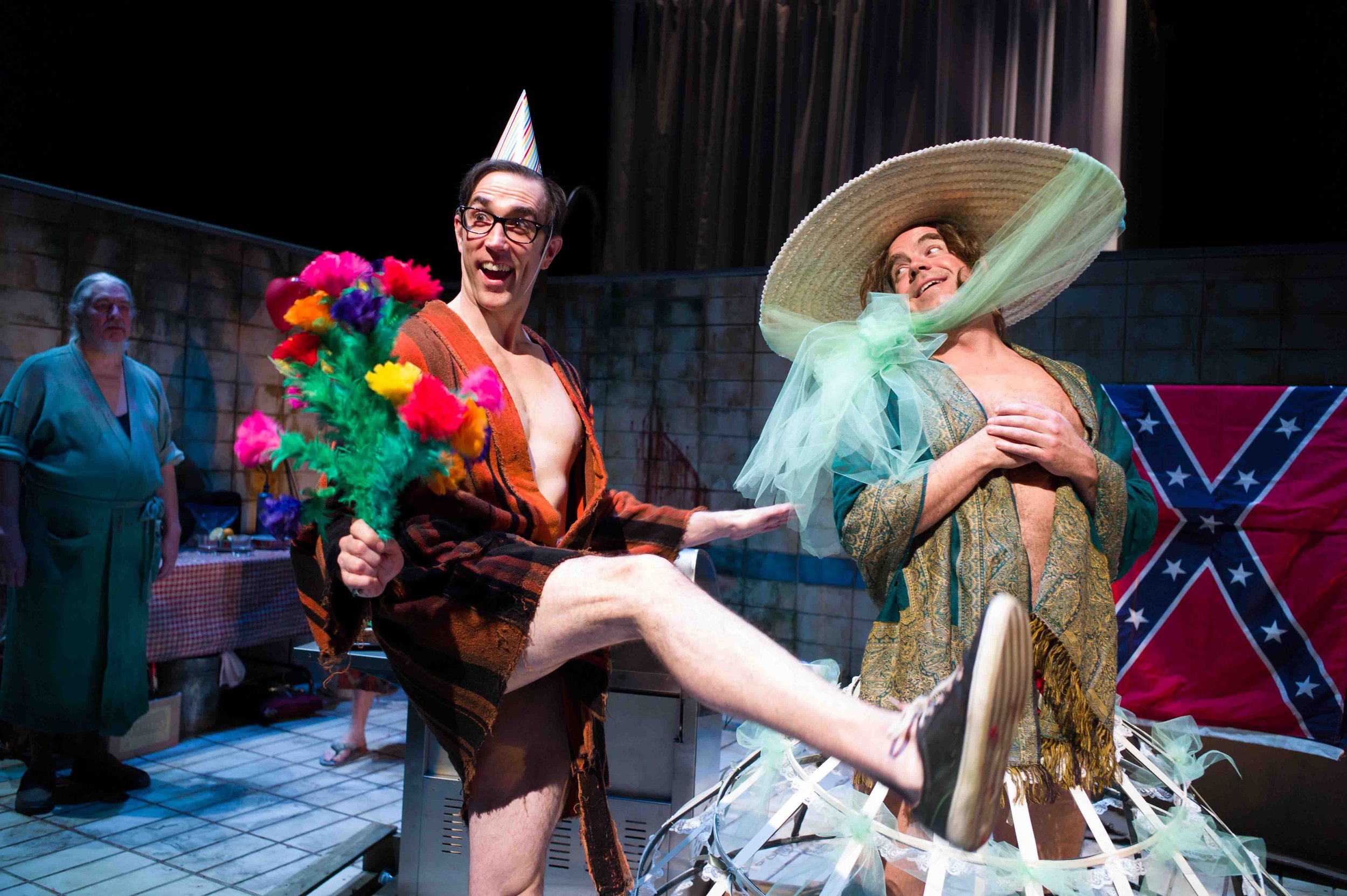Penelope by Enda Walsh
“You’re playing for our lives, Dunne! Seduce well, and may the gods spare us!”
A Regional Premiere directed by Stan Wojewodski Jr.
January 10 – 26, 2013 at The Dallas City Performance Hall
It is twenty years since Odysseus left to make war on Troy. In his absence, prominent citizens have been competing for his wife’s hand. Now only four suitors remain. Each day they come to the drained swimming pool behind Penelope’s house to perform elaborate courtships, and while they await response from the remote woman above them, they contend with one another in physical and psychological combat. The same routine for years on end. Today, however, is different. The last four men have all had a dream: Odysseus will return and put a bloody end to their contest and their lives. In their last day, can the suitors overcome the rot in their souls and band together to win Penelope? Does love have a chance in a pit of barbarous competition?
Undermain had long been a fan of the Irish playwright Enda Walsh’s work (4 Things You Might Not Know About Enda Walsh). His poetic writings were unmistakably unique as the lilting (and often profanity-filled) rhythms of his native Cork danced through the Beckettian concerns of his characters. As Undermain began to program it’s 29th season, the ideas and plays being considered began to circle around the theme of a Season of Myth (What is a Season of Myth anyway?); Penelope, a darkly comic response to Homer’s Odyssey, was a perfect fit. Coincidentally Enda, coming off a Tony award for writing the book to Once: The Musical, had just received the Meadows Prize and would be in residence at SMU with his fellow countryman Michael Keegan-Dolan, a choreographer. Stan Wojewodski, the Chair of SMU’s theatre program, and longtime proponent of Enda’s work, agreed to direct the piece. You can read an exclusive interview with him and his approach to Penelope here.
As Stan began to develop a vision for the piece, the idea of verticality became very important. Set in a drained swimming pool, from where Penelope’s suitors look up at their muse, the play clearly demanded a sense of height that couldn’t be provided in Undermain’s 8’ ceilings. So Undermain began to look for another space to produce the show.
In the mid-2000s, Dallas began to assemble an ambitious plan to grow and develop the Dallas Arts District. The Nasher Sculpture Center, Wyly Theater, and Klyde Warren Park were all built over a decade, bringing most of the city’s major cultural instituions into a walkable proximity just northeast of downtown. The final piece of the Arts District was the building of the Dallas City Performance Hall (DCPH), a city-managed, publically funded theater that would serve as a home in the Arts District for Dallas’ emerging and mid-size performing arts organizations. The DCPH opened in September of 2012, and its proscenium fly provided ample height for the Penelope’s needs. The only problem, the 750-seat house was far too large for Undermain’s needs. In an effort to reproduce Undermain’s intimacy within this new space, the decision was made to lower the proscenium curtain and set the entire audience on the stage left side of the stage, with the set (designed by Undermain newcomer Russell Parkman) taking up the rest of the stage, as if the audience was in one end of the swimming pool and the actors in the other.
In rehearsal the cast worked closely with dialectician Anne Schilling to perfect their Irish accents. Each of the four suitors were named after different powerful Irish businessmen, and Anne developed a slightly different dialect for each character, from all 4 corners of the country. Much time was also spent building the required quick-change show which two of the characters perform in an attempt to impress Penelope. In only a couple minutes the character’s quickly impersonate several famous romantic couples throughout history, Romeo and Juliet, Scarlett O’Hara and Rhett Butler, and JFK and Jackie O.. Costume Designer Claudia Stephens built several intricate (yet quick-change appropriate) costumes for this routine.
Once the production moved into technical rehearsals, the final moment of the play presented a particular challenge. Script requires a barbecue grill on stage to catch on fire and ultimately spark a fire which consumes the entire pool. The technical crew, who had been building in a warehouse down Commerce St. in Deep Ellum, had put together a few different ways of accomplishing this feat—all utilizing light and fog, but it was only when the set was put together in the DCPH that a final solution could be reached. A simple fog machine was not powerful enough to cause the shocking affect needed, so the decision was made to use powerful canisters of CO2 which could be blasted through a hose tracked into the bottom of the barbecue grill and eject a 30 foot pillar of steam. The pillar and eventually entire stage was bathed in red light and a powerful subwoofer pumped bass right below the audience risers; a stunning surprise which planted quite an explanation point on the production.
The production opened on January 12th and ran until January 26th, becoming the first full theatrical production to perform at the DCPH. Penelope sold out almost every performance and had the highest percentage of sold seats ever in Undermain’s history, with 97% of the seats filled over the entire run. TheaterJones called it the “first great production of 2013” and it was featured in American Theater magazine.
Undermain’s first performance in the Arts District was an unprecedented success, exposing Undermain to a whole new audience. Penelope’s success opened the door for a return to the Dallas City Performance Hall one year later, this time with a world-premiere, Abraham Zobell’s Home Movie: Final Reel…















































